|
Part 2: Case Studies
s promised, here are two abbreviated case studies with a comparison between Sole Supports orthotics and Allied OSI orthotics. I submit from the start these are not scientific studies in any way and are purely anecdotal. The problem with scientifically studying orthotic therapy is that there are so many confounding variables that are difficult to control.
Case Study 1–Pediatric Flatfoot
Chief complaint: 3 year old male with flatfoot. |
 by Jarrod Shapiro, DPM
Joined Mountain View Medical &
by Jarrod Shapiro, DPM
Joined Mountain View Medical &
Surgical Associates of
Madras, Oregon July 2008 |
|
|
HPI: Only visible symptoms are patient’s wanting to be carried after short distances and trying to remove shoes after short period of time. No verbal complaints or visible pain signs. No prior treatment. Visibly flat foot appearance. Normal birth history. Apgar 9/10. Normal milestones w/ walking at 10 months.
PMH: Seasonal allergy, atopic dermatitis
All: Miralax (hives)
Surgical history: none |
Sochx: No siblings. No smokers, no pets.
FHx: Father with flatfeet. |
Physical exam: Look at the pictures. No equinus. Flexible flatfoot. Full strength. No focal pain to touch. Normal reflexes. No clonus. No derm lesions or calluses. This calcaneal eversion is greater than the approximately 4 degrees eversion he should have at this age.
Click on the images to view at larger size |
|
|
|
|
Fig. 1 (series): Resting stance position without orthotics (left images), with orthotics (right images). |
This series does not have a comparison with another orthotic company. What I find interesting is the decrease in rearfoot eversion and improved arch position with the orthotics, boiling down to less pronation. The patient is able to walk further distances without wanting to be carried. This orthotic does not have a deep heel cup; it could benefit from one. Additionally, a greater arch would be even more effective.
|
Case Study 2 – Adult Flatfoot and Bunion Pain
CC & HPI: 36 year old male with 15 year complaint of painful bunions, left worse than right, and bilateral foot fatigue, recalcitrant to treatments with multiple custom and OTC orthotics, shoegear changes, physical therapy, and anti-inflammatories. Worse weightbearing, better non-weightbearing and with massage. Sharp joint-centered pain, especially in the left 1st MTPJ with increased activity.
PMH: Allergic rhinitis, migraine headaches
Allergies: NKDA |
Medications: occasional Motrin 600mg
ROS: normal |
SocHx: No ETOH, smoking, or recreational drug use. Semi-active 30 minute/day walker, karate 2x/wk. Married. One child.
Family history: notable bunions, flatfoot in parents, siblings. Father alive w/ DM, CAD, HTN, hyperlipidemia.
Physical exam: Take a look at the photos. I’ll eliminate the detailed descriptions to save time. What the pics don’t show is functionally limited 1st ray motion, a flexible/reducible flatfoot with severe midstance pronation, and normal muscle inventory (including the PT tendon). Also, notable decrease in ankle joint dorsiflexion with knee extended vs. flexed with tight hamstrings. For all of you surgeons I can feel you salivating over what you’d do if I were on your OR table! Fly to Madras, Oregon, cover my practice while I’m recuperating, and you can reconstruct my foot. |
|
Fig. 2: Preorthotic calcaneal axial clinical view in resting stance
|
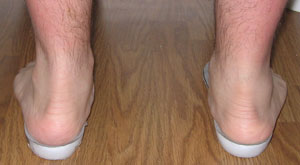 |
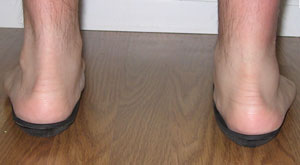 |
Fig. 3 :
Resting calcaneal axial view with Allied OSI orthotics (left) and Sole Supports orthotics (right) |
|
|
Fig. 4: Preorthotic lateral clinical view |
| |
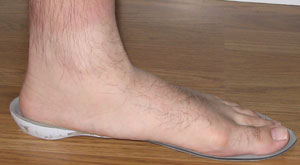 |
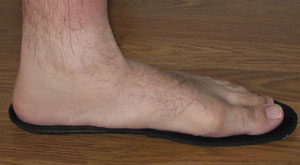 |
Fig. 5: Resting lateral view with Allied OSI orthotics (left) and Sole Supports orthotics (right) |
| |
Conclusions:
The photo series shows a comparison between the foot position with Allied OSI orthotics (prone neutral suspension casting method) vs. Sole Supports orthotics (MASS position casting method). From a patient satisfaction standpoint my hallux limitus symptoms have almost completely resolved after wearing the Sole Supports orthotics for 8 weeks. I have the very occasional joint pain in the left MTPJ after extreme activity. I have also noticed less foot fatigue, especially after the break-in period, which took slightly longer than other orthotics I’ve tried.
I was concerned at first that I wouldn't be able to tolerate the arch height, but it turns out my concern was unwarranted. I could actually tolerate greater height than what I currently have. Overall, I am 85% symptomatically improved in comparison with the Allied OSI orthotics. One note: the person who casted me for the Allied OSI orthotics did not plantarflex my first ray during casting, which affects the arch height. Perhaps this would have made those prior orthotics more effective. With that said, these orthotics are the single most effective ones I’ve tried to date. I am now a convert to the MASS position casting techniques and Sole Support orthotics.
What has been your orthotic experience?
Write in with your comments – I welcome a healthy biomechanical debate!! Best wishes. |

Jarrod Shapiro, DPM
PRESENT New Docs Editor
[email protected]
GRAND SPONSOR
This program is supported by
an
educational grant from
STRATA DIAGNOSTICS
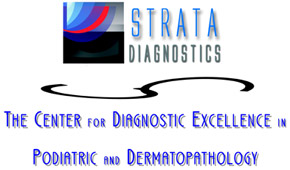 MAJOR SPONSORS
MAJOR SPONSORS
|
|
|
|
|
|
|
|
|
|
|
|
|
|
|
|
|
|
|
|
|
|
|
|
|
|
|
|
|
|
|
|
|
|
|
|
|
|
|